When you’re building a WordPress website, it’s tempting to install a plugin for every little feature you want. A slider here, a pop-up there, a social sharing bar, SEO optimization, contact forms, the list goes on and on.
But the truth is that more plugins don’t always mean a better website. In fact, installing too many can slow your site down, make it more vulnerable to attacks, and cause unnecessary headaches.
As someone who works with WordPress regularly, I’ve learned to keep things simple. Personally, I only use Elementor Pro and Advanced Custom Fields, and WPform Lite when needed. The fewer moving parts, the better.
Before you install that 12th plugin let's break down why you should think twice.
How Too Many Plugins Can Harm Your WordPress Website
Your Website Will Get Slower
Every plugin adds more code to your website, and that means more things your server has to load each time someone visits your website.
According to recent findings, popular plugins like WooCommerce can increase your load time by up to 30%, while an SEO plugin like Yoast can slow things down by as much as 55%. Imagine combining five or six of these on a small site, it’s a performance disaster waiting to happen.
And when your site is slow, visitors leave. Google even uses page speed as a ranking factor. So this isn't just about user experience, it's about visibility too.Security Risks Go Up
Each plugin you install increases the number of doors into your website. If any of those doors aren’t secure, maybe because the plugin is outdated, poorly coded, or no longer maintained, you’re leaving your site vulnerable.
In 2023, WordPress had to take over the widely used Advanced Custom Fields (ACF) plugin to fix security issues and remove shady upsells. And that’s a popular, trusted plugin. Now, think about those obscure ones with 500 installs and no updates for 2 years.
It only takes one vulnerable plugin for your site to be compromised.Plugins Can Clash With Each Other
Plugins are built by different developers. They aren’t always designed to work together, and sometimes... they fight.
One plugin update might break something else. Or two plugins might try to do the same thing in different ways, causing bugs you don’t even notice, until your layout breaks or, worse, your entire site goes offline.
I’ve experienced this multiple times, especially when a plugin starts conflicting with a must-use (MU) plugin. It can get really frustrating. These MU plugins are often essential to the site's core functionality, and when something breaks them, troubleshooting becomes a nightmare.
When you have 20+ plugins installed, figuring out what broke what becomes a guessing game, and that’s time you could’ve spent building your content or growing your brand.You’ll Spend More Time Managing Your Site Than Growing It
More plugins mean more updates. More updates mean more testing. And when something goes wrong, good luck figuring out which plugin caused the issue.
If you're not a developer or tech-savvy user, managing a bloated site can get exhausting. Instead of focusing on content, sales, or growth, you’re stuck fixing errors and reading through plugin changelogs.
So, How Many Plugins Are Too Many?
There’s no one specific answer, but a good rule of thumb is:
Use as few plugins as possible.
Focus on:
- Quality over quantity
- Multi-functional plugins (like Elementor Pro, which replaces the need for multiple smaller ones)
- Your specific use case
For most sites, 2 to 5 plugins are more than enough. And if you're a beginner, try to stick to the essentials only. Ask yourself before installing anything: Do I really need this? Can I achieve the same result another way?
Alternatives to Using Too Many Plugins
- Use WordPress's built-in features. It’s more powerful than most people realize.
- Use code snippets (if you're comfortable with basic PHP) to add small features.
- Choose a lightweight, well-coded theme that already includes the design and functionality you need.
- Invest in one powerful plugin (like Elementor Pro) instead of stacking multiple free ones.
Best Practices for Plugin Management
- Audit your plugins regularly if you're not using it, remove it.
- Update everything. Outdated plugins are the #1 way hackers get in.
- Check reviews and compatibility before installing anything.
- Don’t download plugins from unknown or untrusted sources.
So here is my conclusion: Keep It Simple, Keep It Safe
Plugins are amazing. They help you build powerful websites without touching code. But like anything else, too much of a good thing can be harmful.
Keep your plugin list short. Use only what you truly need. Always prioritize performance, security, and ease of maintenance over flashy features you might never use.
Your future self (and your visitors) will thank you and, hopefully thank me too.




Top comments (1)
At some point, I stopped installing WordPress because it's just a blogging software. It's not a shop software or something like that. 🤷♂️
Some comments may only be visible to logged-in visitors. Sign in to view all comments.